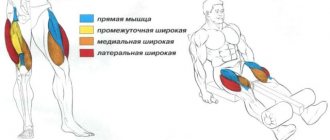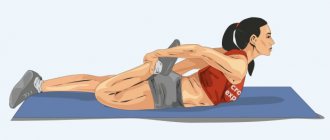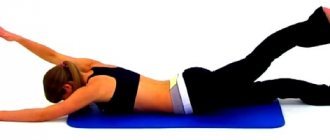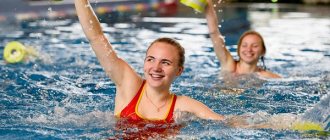Splits for beginners may seem like a difficult element that many people are reluctant to attempt. However, like any physical exercise, after hard training you will be able to do the splits, even if you are not naturally flexible.
What kind of splits are there?
Gymnastics and acrobatics include various types of splits. Some you can learn in a couple of months of hard training, while others will take six to a year to master.
Twines are divided into several main types:
- Longitudinal
- Transverse
- Classical
- Provesny
- Horizontal
- Vertical
- Half twine
Let's take a closer look at each of them.
Cross twine
The essence of the cross split is to spread your legs to the maximum angle in different directions. Even despite training, some people, due to their physiology, will not be able to perform this element - the problem lies in the structure of the pelvis, which does not allow the body to take this position. By the way, it is easier for men to master cross splits than for women - women's hips are not well suited for such exercises.
Longitudinal twine
With a longitudinal split, the legs are spread in two directions - forward and backward. A correctly taken position forms a longitudinal line in the direction of the legs.
Here, unlike the cross split, women have a slight advantage - men have a powerful back of the thigh, which is quite difficult to develop for the longitudinal split.
Classic twine
This element comes from acrobatics. The exercise consists of positioning your legs so that the angle between the inner surfaces of your thighs is one hundred and eighty degrees.
Hanging twine
This version of the twine must be done especially carefully; it will require remarkable flexibility. You need to start the exercise standing on a support and gradually sitting down on the splits, as shown in the picture below. After taking the correct position, it turns out that the angle between the legs is more than 180 degrees, since one of them is on a support. That is why this option is called “suspended”.
Horizontal twine
Based on the name, the legs should be directed in different directions along the horizon line.
Vertical twine
The vertical version of the twine is best done with a support that you can hold on to with your hands - it will be easier and safer. The legs are spread from a standing vertical position, one leg is raised vertically up, perpendicular to the floor.
Half twine
The half split is a good preparatory exercise for the full split version. It will take several training sessions to complete it. Sit on the floor, bend one leg as far as possible toward you, and extend the other back. Lock yourself in this position and stretch your body towards your extended leg.
Warm-up before the splits
To do the splits without injury, you need to warm up your muscles; to do this, perform a set of exercises that are described below.
Butterfly
This exercise is aimed at stretching the thigh muscles, especially the inner part. It also increases the flexibility of the inguinal ligaments, which play an important role in the splits.
Sit on the floor, bend your legs and bring your feet together, pulling your heels towards you, as shown in the picture. Place your hands on your knees and try to press them into the floor. Your back should be straight and you should not feel any pain. If there is no discomfort, try to stretch both arms and stretch your whole body forward.
Frog
This type of warm-up exercise is particularly good at stretching the inguinal ligaments and inner thighs. Take the starting position - lie on your stomach on the floor. Spread your legs in different directions, bend your knees. Press your feet together so that your body forms a “P”. Try to hold this position for several minutes, then slowly bring your feet together, keeping your pelvis on the floor.
Floor socks
This exercise strengthens and stretches the thigh muscles, ligaments in the groin and behind the knee. Go to the wall and lie on your back. Raise your legs up, pull your body towards the wall. Start spreading your legs in different directions, carefully, without sudden movements. Move to the maximum distance, lock in this position for several minutes. Return to the starting position also slowly and carefully, without jerking.
Necessary exercises for stretching muscles
Warm-up, warming up the muscles. How to do it, how much. The main mistake made by those who want to do the splits is starting classes without prior preparation. Before you begin physical exercises to stretch the ligaments, as mentioned above, you need to warm up and stretch the muscle tissue well. To do this, it is enough to spend some 10 or 15 minutes on light physical exercise:
- running in place
- jumping rope,
- jumping in place,
- squats,
- circular rotations with legs bent at the knees,
- dancing.
Below are the necessary exercises to obtain the desired result.
Muscle stretching
1. To perform it correctly, you need to sit on the floor and spread your legs in a V. The wider they are apart, the better. While maintaining this position of your legs, bend your body towards your right leg, trying to clasp your feet with your hands. Then repeat the bends to the center and to the left leg. Stretch, try to get as low as possible. You need to feel the muscles stretching. Duration - 1 min.
2. For the next exercise, sit on the floor, fold your legs together and extend them forward. And bend forward again, with your arms extended. Try touching the floor or your toes. It costs 30 seconds to stretch the muscles in this position.
This exercise can be repeated while standing. In this case, your legs should be spread slightly wider than your shoulders.
Swing your legs
In addition to stretching exercises, leg swings will be very useful. Thanks to them, you can not only stretch the ligaments in your legs, but also strengthen your muscles. They need to be performed in different positions: standing or lying on the floor sideways.
Lying down. In order to perform swings on your side, you need to lie on a flat, hard surface, in the gym this can be either a bench or the floor. Experts advise placing a fitness mat under your body, so it will not slip, which means the exercise will be easier to do.
Lying on the floor, raise your leg, fix it in this position for 20-25 seconds. The exercise is performed either completely lying on your side or leaning on your arm bent at the elbow. Repeat the swings 25-30 times, changing positions from left to right side.
Standing. In a standing position, swings are performed forward, backward and sideways. They are done in several approaches, 25-30 times in each direction.
Rotations of the head, arms and legs
Rotations are necessary to stretch ligaments and strengthen leg muscles. They should also be done to warm up and tone the whole body.
Rotating your head will help you relax your body and thereby prepare it for the upcoming physical activity. They can be performed both sitting and standing. To do this, you need to lower your head down and rotate it clockwise for 30 seconds. Next, you should change direction.
Leg rotations are an equally important exercise for warming up and stretching muscles.
Standing on the floor, raise your leg - do not lift it too high. Start making movements in a circle. First, rotate your leg to the left and then to the right. Switch legs. Rotate in each direction for 30-40 seconds, 2-3 approaches. For stability, you can rest your hand on a wall or the back of a chair.
You can also rotate your legs while sitting on the floor. To do this, move your arms behind your back and place your palms on the floor. Important: the spine must be straight. Start making circular movements similar to a standing position. But in this case, the leg needs to be raised as high as possible.
If desired, you can do additional leg rotations while lying on your back. In this case, the leg with which the circular turns are made must be kept as straight as possible, and the leg lying on the floor without bending at the knee. Spend 30-60 seconds on each side. Don't forget to change direction.
Rotation of the foot. You can perform this exercise in any comfortable position, but it is better to stand. Make circular movements to the right and left, while trying to stretch your toes as much as possible.
Arm rotations are useful for warming up the body muscles. This type should be performed in a standing position. Place your feet together and extend your arms forward. Make sequential movements: raise your arms above your head, then spread them in different directions so that they are parallel to the floor. Lower it down, then extend it in front of you and lift it up again. The rotation should be repeated 20 to 30 times.
Afterwards, remaining in a standing position, spread your arms in different directions. Start making circular movements with them. Rotate your hands for about a minute.
Tilts
Those who want to learn how to do the splits at home know firsthand how important bending is. Thanks to them, you can stretch the muscles of the whole body, and especially the back and legs.
Tilts are performed from two positions, sitting and standing. But in order to properly stretch the muscles on the legs, and especially the popliteal ligaments, it is worth doing them from a vertical position, that is, standing. To do this, spread your legs about 1 m wide. This helps to better stretch the ligaments.
Bend over with hands clasped in a “lock”. It is necessary to stand on the floor, the spine should always be straight. Your feet should be spaced slightly wider than your shoulders. Take your hands behind your back and clasp them in a “lock” with your palms down. Bend as low as possible. Raise your arms up without releasing the lock, trying to pull them in line with your legs. Take the original body position. Tilt again, and so on 15-20 times.
A similar exercise can be done with your hands clasped in a “lock” above your head. When bending in this case, your arms should be parallel to the floor. The pose should be held for 20-25 seconds.
Tilts towards the feet. They can be performed in an upright position or while sitting on the floor. In any case, the back should be straight. While standing, lean forward and then down. You cannot bend your knees. If the exercise is performed correctly, muscle tension will be felt in the back and under the knees. Hold this position for at least 20-30 seconds. Such tilts are static.
Bend down and back. Standing on the floor with your feet slightly wider than your shoulders, bend down, trying to reach your hands to the floor. This exercise should be repeated several times in a row. Such downward and backward bends are static.
Tilt to one leg. Sitting on the floor, extend your legs forward. The back, as in previous cases, should be straight. Raise your arms above your head and slowly lean forward. Try to clasp your right foot with your hands. Lock in this position for 25-40 seconds. Take the initial pose and do another 15-25 bends. Then repeat the exercise, but it is advisable that the right leg is bent at the knee joint.
Thigh stretch
To perform this exercise, you should stand in a lunge, with your left knee pointed forward and bent at a right angle, and your right knee lying on the floor. With your left hand we pull the foot towards the buttocks, while trying to lower the groin down. For balance, we rest our free hand on the floor; if this is difficult, then place books or a fitness brick under your hand. Try to put your weight on your front leg.
Power stretching from a standing position
This stretching is done with the hands, and it can be more effective than stretching with body weight pressure. The exercise must be performed standing straight and keeping your legs together. Try to transfer all the weight to your left leg, bend your right leg at the knee joint and, clasping it with both hands, gently lift it up. Try to lift it as high and straight as possible, pulling it towards your body with your hands.
Exercise "Fold"
This exercise perfectly stretches the muscles of the back and buttocks, and is also suitable for working out the abs.
Lie on your back with your legs and arms extended forward. At the same time, begin to lift your arms and legs off the floor, lifting them up. Bend your knees slightly. Try to touch your toes with your fingers. It is very important not to strain your back; twisting must be done using the abdominal muscles.
Lock in this position for 10-15 seconds, then return to the starting position. Repeat the exercise 10-15 times.
Double crunches
To perform the exercise correctly, you must lie on the floor. The legs are bent at the knees, and the hands are placed behind the head. Elbows should point in different directions. As you exit, begin to lift your torso and at the same time press your legs towards your body - do this until your legs touch it. Hold this position for 30-40 seconds. Return to the original position.
Final recommendations
Please use caution. Many, trying to do the splits as quickly as possible, perform exercises without prior preparation. And this can lead to ligament rupture, therefore, to a long recovery period.
Failures can occur when training rules are not followed, excessive haste in achieving results, or when expert advice is ignored. Be patient and follow the recommendations.
Twine stretch
Basic exercises that are aimed at improving muscle elasticity, strengthening joints and stretching ligaments.
Lunge
Bend one leg at the knee, lower your body closer to the floor, moving the other leg back. Lean on the foot of your other leg, pull your pelvis towards the floor. Your arms can be raised up or placed on your knees.
Pigeon
Sit on your knees, then take one leg back, bend the other at the knee and throw it forward. Your body weight should be on your front leg, with your hands on the floor. If the exercise is easy, you can increase the load by placing your chest on the calf of your extended leg.
Knee Lunge
Take the same position as in the “Lunge” exercise. Bring your hands to your front leg, place your back leg on the floor so that your knee touches it. Straighten your back, place your hands on the pelvic area, bend slightly back.
Doing the splits at home: the main stages of skill training
Is it possible to learn the splits in 5 minutes a day? People tend to look for easy ways, to achieve what they want without effort. Get in the right mindset right away - you can train for 5 minutes a day, but it will take many months. The work algorithm for a beginner is as follows: first, a high-quality long warm-up, then performing flexibility exercises, at the end of an attempt to do the splits, measuring the current result. Let's look at everything in order.
Warm-up
As a basic warm-up, you can use classic exercises from physical education lessons at school: rotation of the arms at the elbows, in the shoulder joints, turning the head clockwise and back, squats in place, warming up the hip area with rotations, warming up the legs and feet, lunges in place. If possible, you can jog for 10-15 minutes; running is a universal warm-up for the whole body. You can learn the splits at home, not forgetting the following exercises for stretching the muscles of the lower body:
- Bend forward with arms outstretched, the goal is to touch your toes with your toes. 4 bends forward, 4 bends back, arching your back well, 4 bends to the sides, while you can keep your hands on your belt;
- Complex squats with changing legs - first you need to squat on your left foot, extend your right leg towards your body and place it on your heel. Next, a smooth transition is made: bending the right leg and resting on its foot, while stretching the left leg to the side, placing it on the heel;
- An exercise for pelvic flexibility - place your feet shoulder-width apart, hands on your belt and begin circular rotations with your pelvis, while bending slightly towards the inclination;
- Stretch your feet - lean your hands on something, lift one leg and move your foot clockwise and counterclockwise, then change your foot to the other.
In general, any warm-up routine found on the Internet will do, but it’s better if it focuses on the lower body.
Twine exercises
To quickly learn how to do the splits, you will need to diligently perform basic exercises that develop flexibility and strengthen joints and ligaments. Here are some great exercises that are worth a try for beginners.
Swing your legs. Take a position lying on your side on the floor. Next, you need to raise your leg up, trying to take it as far as possible from the floor, while trying to literally hold your leg in the upper position for 15-20 seconds. It will be difficult for beginners, but this exercise perfectly develops flexibility, ligaments and will quickly bring you closer to the splits. Repeat the movement 20-25 times, then roll over to the other side and do the same with the other leg. You can do this exercise while standing - rest your left hand on a support, begin to lift your right leg up along your body, trying to bend it minimally at the knee, then change sides.
Bends to the sides in a sitting position. Sit on the floor, spread your legs to the sides like the letter “V”, preferably so that they are spread as far apart as possible. Now you need to bend your torso towards each leg in turn. The goal is to easily grasp the foot with your hands. It is very important to try to keep your back as straight as possible so as not to slouch. The duration of the bends is 30 seconds per side.
Bend forward. In a sitting position, bring your legs together. Now try, as in the previous case, to lean your torso forward so that, with a straight back, you can cover the feet of your closed legs with your palms. If you can’t reach your feet, then this goal is enough to start with – reaching your toes with your fingers. If the exercise is easy for you, then you can try to complicate it by performing it in a standing position.
Lunges. Already mentioned in the warm-up section, but this particular exercise is important for stretching and getting closer to your dream - the splits. From a level position, take a wide step forward so that the other leg extends as much as possible and remains behind your body, touching the floor with your toe. The leg brought forward should stand firmly on the entire foot. After standing in this position for 25-30 seconds, you need to change the position of your legs on the contrary. Lunges can be done on the spot or while walking around the room with their help.
Lunges for split stretches
Here are 2 more universal exercises for splits:
- While lying on your back, you need to bend one leg at the knee and place it on the floor, and the other, keeping it completely straight, lift it up as much as possible. When the leg has reached the top position, you need to grab it with your hands and gently pull it towards your chest, while continuing to keep it level, without bending the knee. 20-25 seconds one leg, then the other;
- Tilts. We place one leg in front of the body so that the foot is directed along the direction of the hip. The other leg is brought back slightly, turning the foot outward, at approximately 40-50 degrees. Next, you need to bend along your outstretched leg, bending as far as possible to the floor. Ideally, you need to reach a state where, with straight legs, you reach the floor with your elbows.
Exercises for splits
Those who want to know how to learn splits in 1 day will be bitterly disappointed - you can find out in 1 day, but you definitely can’t start doing them. You will have to spend at least some time every day for a month or more on these exercises, trying to make progress in them in order to do the splits.
How long to train to do the splits?
The time it takes to fully master the exercise depends on perseverance, the physiological characteristics of the body and the amount of training.
If before this a person was engaged in gymnastics and regularly did stretching exercises, then the splits can be mastered in one to two months. If there is no such experience, much more time is needed.
Physiology in your 20s can significantly impact the time it takes to achieve your goal, both positively and negatively. Gender also plays an important role - it will take men from six to ten months to do the splits from scratch. This happens because stretching muscles and ligaments is much easier for women than for men.
Do not forget that twine has some contraindications. You cannot perform the exercise if you have:
- Problems with the spine;
- Osteoporosis;
- Osteochondrosis;
- Pathologies and chronic diseases associated with the circulatory system;
Tips on how to do the splits faster
These tips will help you learn the splits faster.
- The elasticity of muscles and skin depends on the amount of water consumed by a person. It will be a little easier to do the splits if you regularly drink the required amount of liquid;
- It is not recommended to do stretching exercises and do the splits when you are feeling unwell, have an exacerbation of some disease, or have a critical period;
- A hot shower before training will help warm up and improve the elasticity of the muscle system and skin;
- A short massage before starting a workout will be helpful;
- Eat right: in the morning - complex carbohydrates and fiber, at lunch - protein and fats, and in the evening for dinner - quickly digestible carbohydrates;
- Along with stretching, do running exercises and cardio training. This will help strengthen muscles, prepare the body for stress, and improve blood circulation.
What affects flexibility and stretching
- FLOOR
Men generally have less flexibility than women. The fair half of humanity can more easily endure physical stress that involves spraining ligaments, muscles and tendons. Due to this, they learn to do the splits faster and easier.
- AGE
The younger the person, the more flexible the ligaments are and easily stretch. It’s not in vain that children who have learned to do the splits when they stop training at an older age will do it faster than those who have not trained at all. Adults can also sit down, but more time will be needed.
- NATURAL DATA
Everyone by nature has their own flexibility, some find it more difficult, others find it easier to achieve results. Anyone can do the splits, it all depends on the time and effort spent.
- DIET
Few people know, but nutrition affects the rate at which muscles stretch. Drinking more water will improve flexibility, and eating more protein will help muscle fibers, ligaments and tendons recover more quickly after workouts.
- PHYSICAL FITNESS
For people leading an active lifestyle with constant body training, it is faster and easier to do the splits, since the muscle fibers are more prepared for stress loads.











